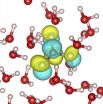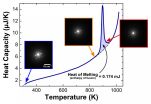Finding durable foul-release coatings to control invasive mussel attachment
Bureau of Reclamation six year research report details findings of more than 100 anti-fouling and foul release coatings and materials tested for mussel control
2014-10-22
(Press-News.org) The Bureau of Reclamation has released a report summarizing six years of testing coatings to control the attachment of quagga and zebra mussels to water and power facilities. Since the study began in 2008, Reclamation has tested more than 100 coatings and materials.
"Controlling attachment of invasive quagga and zebra mussels on Bureau of Reclamation facilities is important to ensure water delivery and hydropower generation," principal researcher Allen Skaja said. "Though we have tested many different coatings, three durable foul-release coatings are showing promise in managing mussels."
The Silicon Epoxy allowed mussels to attach but were easily cleaned for the first 12 months of exposure. Two experimental formulations prevented mussel attachment for the first 18 months. These three durable foul release coatings will be tested further.
Silicone foul release coatings are the most promising for deterring mussel attachment in flowing and static water. Though aquatic vegetation and algae may provide a surface for attachment, the coatings can be easily cleaned with no measurable force. Unfortunately, silicone foul release coatings are soft and are easily damaged.
The testing was conducted at Parker Dam on the Colorado River. Invasive mussels at this location reproduce year-round and have a high growth rate. Each coating system was tested in static and flowing water conditions at the dam. Each coating system was evaluated approximately every six months, about every May and November.
The research was funded by Reclamation's Research and Development Office where research is conducted to develop and deploy successful solutions to improve water management practices, increase water supply and ensure cost-effective power generation operations.
INFORMATION:
To view the report, please visit Reclamation's Quagga and Zebra Mussel Website.
ELSE PRESS RELEASES FROM THIS DATE:
2014-10-22
Worcester, Mass. – People paralyzed by spinal cord injuries lose mechanical strength in their leg bones faster, and more significantly, than previously believed, putting them at greater risk for fractures from minor stresses, according to a new study by a research team at Worcester Polytechnic Institute (WPI).
The results suggest that physicians need to begin therapies for spinal cord injury patients sooner to maintain bone mass and strength. The data also serve as warning to physicians treating patients with osteoporosis to think beyond the standard bone density ...
2014-10-22
Combining a PET scanner with a new chemical tracer that selectively tags specific types of bacteria, Johns Hopkins researchers working with mice report they have devised a way to detect and monitor in real time infections with dangerous Gram-negative bacteria. These increasingly drug-resistant bacteria are responsible for a range of diseases, including fatal pneumonias and various bloodstream or solid-organ infections acquired in and outside the hospital.
"What we have produced is essentially a system that localizes the epicenter of infection and provides real-time tracking ...
2014-10-22
The National Institute of Standards and Technology (NIST) has published the final version of the US Government Cloud Computing Technology Roadmap, Volumes I and II. The roadmap focuses on strategic and tactical objectives to support the federal government's accelerated adoption of cloud computing. This final document reflects the input from more than 200 comments on the initial draft received from around the world.
The roadmap leverages the strengths and resources of government, industry, academia and standards development organizations to support technology innovation ...
2014-10-22
A University of Colorado Cancer Center study recently published in the journal Prostate offers compelling evidence that inflammation may be the link between Vitamin D and prostate cancer. Specifically, the study shows that the gene GDF-15, known to be upregulated by Vitamin D, is notably absent in samples of human prostate cancer driven by inflammation.
"When you take Vitamin D and put it on prostate cancer cells, it inhibits their growth. But it hasn't been proven as an anti-cancer agent. We wanted to understand what genes Vitamin D is turning on or off in prostate cancer ...
2014-10-22
Though it garners few public headlines, carbonic acid, the hydrated form of carbon dioxide, is critical to both the health of the atmosphere and the human body. However, because it exists for only a fraction of a second before changing into a mix of hydrogen and bicarbonate ions, carbonic acid has remained an enigma. A new study by Berkeley Lab researchers, has yielded valuable new information about carbonic acid with important implications for both geological and biological concerns.
Richard Saykally, a chemist with Berkeley Lab's Chemical Sciences Division and a professor ...
2014-10-22
When studying extremely fast reactions in ultrathin materials, two measurements are better than one. A new research tool invented by researchers at Lawrence Livermore National Laboratory (LLNL), Johns Hopkins University and the National Institute of Standards and Technology (NIST) captures information about both temperature and crystal structure during extremely fast reactions in thin-film materials.*
The combined device will help scientists study new materials and processes used to make advanced technologies, including state-of-the-art semiconductors and flat-screen ...
2014-10-22
Abandoned penguin chicks that were hand-reared and returned to the wild showed a similar survival rate to their naturally-reared counterparts, according to a study published October 22, 2014 in the open-access journal PLOS ONE by Richard Sherley from University of Cape Town and colleagues.
The Endangered African penguin population has been rapidly decreasing since 2001. In the Western Cape of South Africa, penguins breed from February to September and moult between September and January, once chicks have fledged. If adult penguins begin the moulting process, a 21 day ...
2014-10-22
Wild chimpanzees living in disturbed habitat may use innovative strategies, like foraging crops at night, to coexist with nearby human activities, according to a study published October 22, 2014 in the open-access journal PLOS ONE by Sabrina Krief from Muséum national d'histoire naturelle and colleagues.
People expanding land use for agriculture and other activities are increasingly encroaching on wild chimpanzee habitat. To understand how chimpanzees are adjusting, researchers used camera-traps to observe chimpanzee behavior during incursions out of the forest into ...
2014-10-22
VIDEO:
This video shows treatment with OTS964 induced cytokinetic defect with inter-cellular bridges that eventually led to cell apoptosis. Cell pictures were taken every 10 min.
Click here for more information.
A new drug, known as OTS964, can eradicate aggressive human lung cancers transplanted into mice, according to a report in Science Translational Medicine. The drug, given as a pill or by injection, inhibits the action of a protein that is overproduced by several tumor types, ...
2014-10-22
Males of great bustard consume small doses of poison with a dual purpose: to eliminate intern parasites and, especially, to look healthier and stronger before females, allowing them to achieve a greater reproductive success. A team of researchers from the Spanish National Research Council has now suggested for the first time that this function of self-medication could be a mechanism of sexual selection. The study results are published in the PLOS ONE journal.
Juan Carlos Alonso, who led the project, CSIC researcher at the Department of Evolutive Ecology of the Spanish ...
LAST 30 PRESS RELEASES:
[Press-News.org] Finding durable foul-release coatings to control invasive mussel attachment
Bureau of Reclamation six year research report details findings of more than 100 anti-fouling and foul release coatings and materials tested for mussel control




